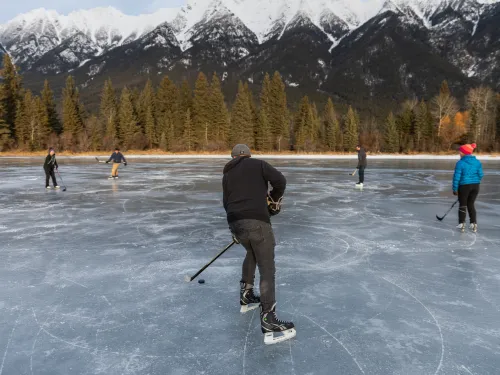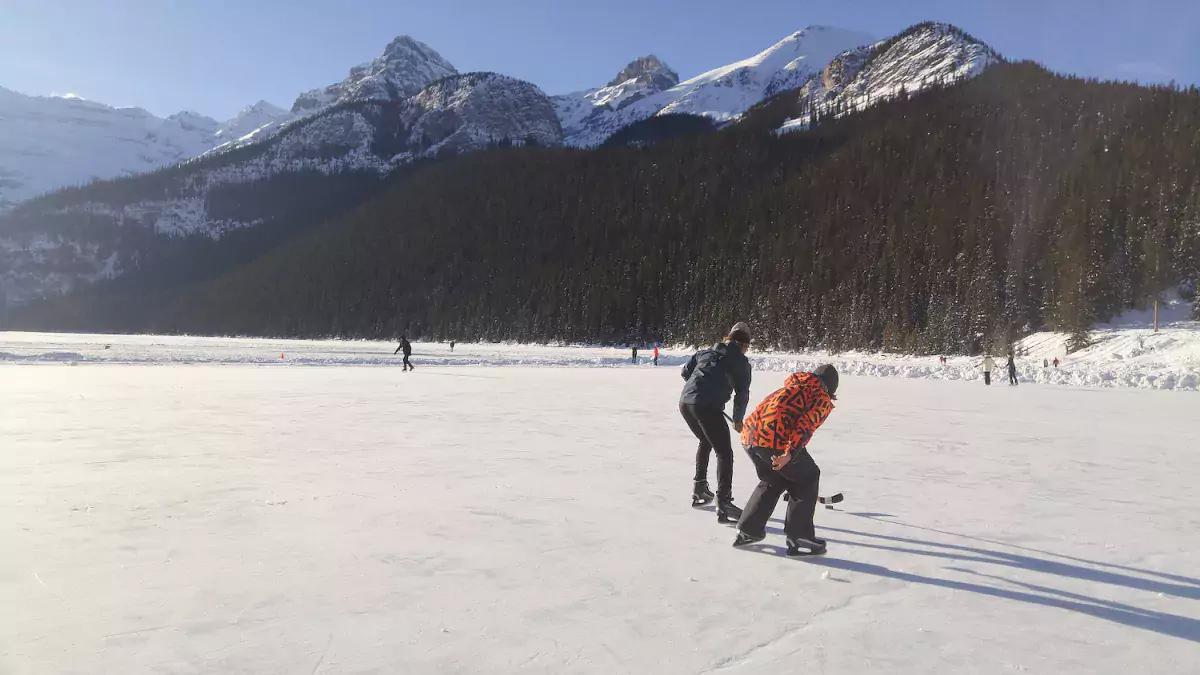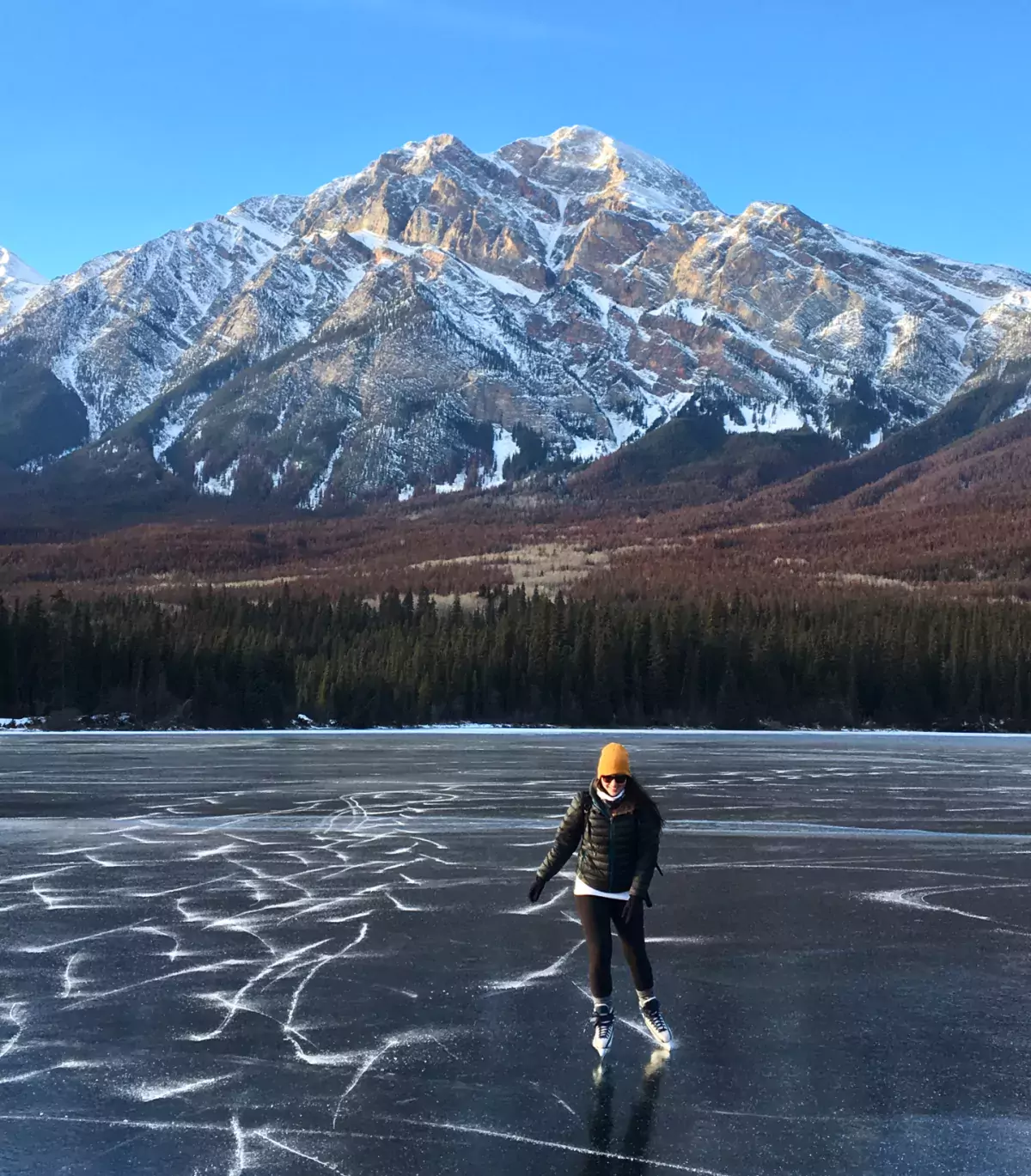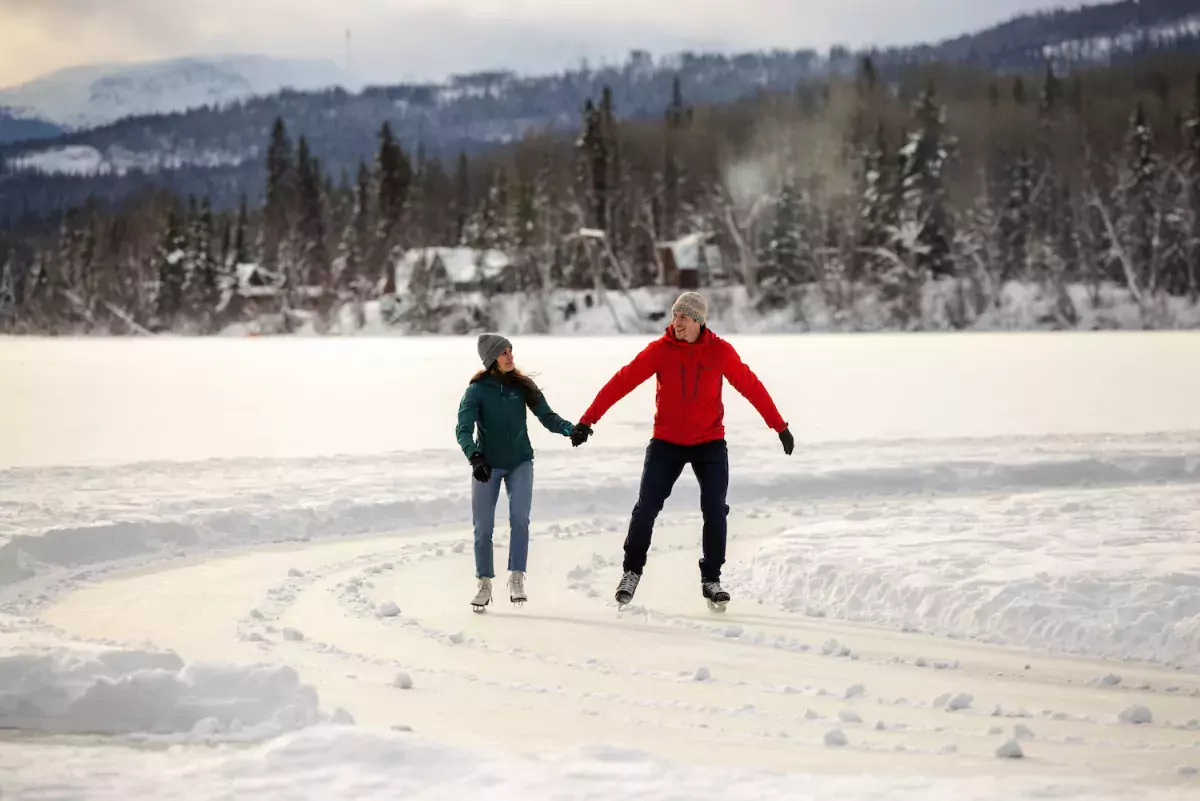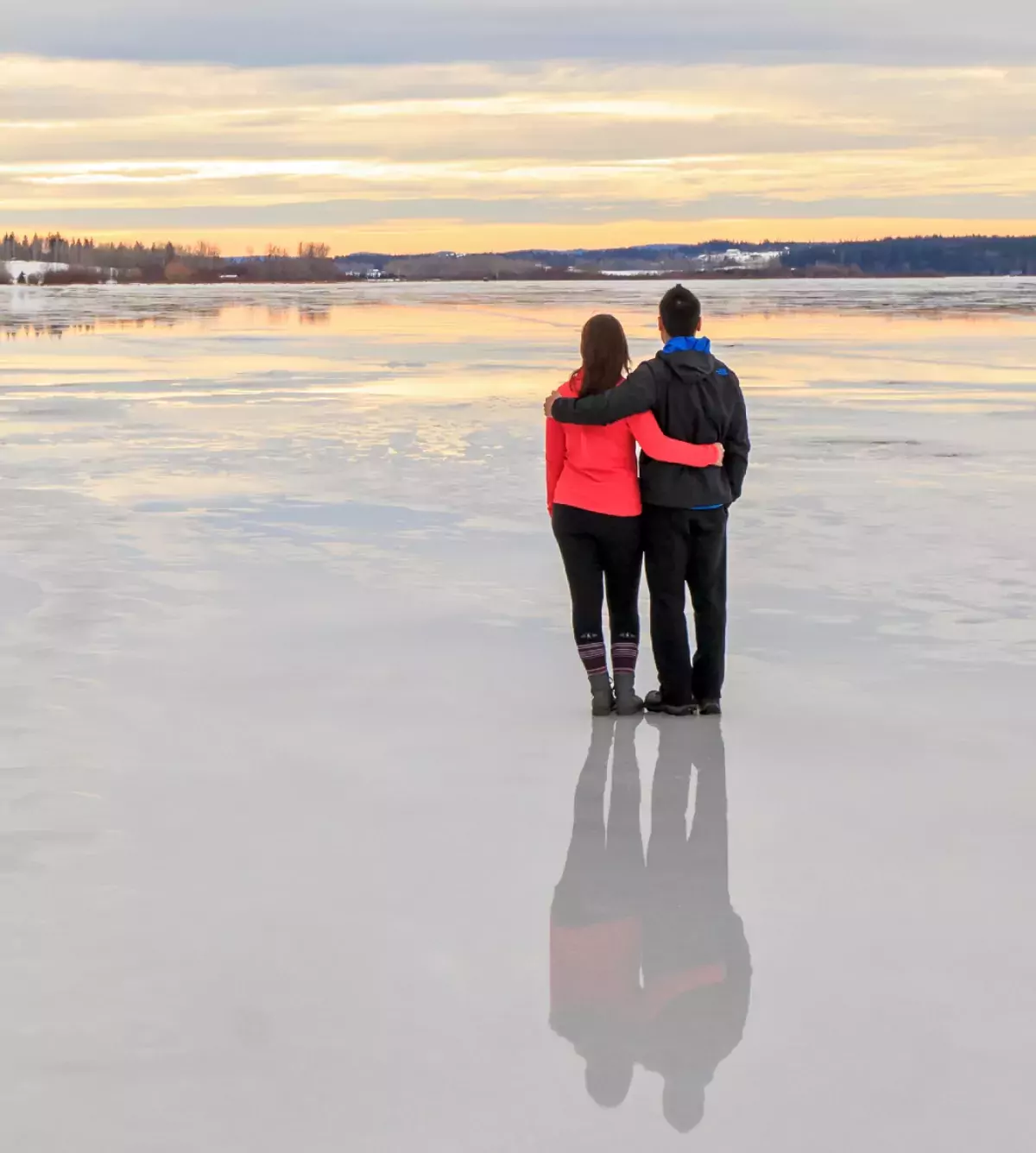Chasing wild ice: skating on mountain lakes in Western Canada
Is there anything more Canadian than lacing up your skates next to a frozen lake? Skating on a glassy lake beneath majestic mountain peaks is a classic piece of Canadiana, and the inspiration behind a growing interest in wild skating.
Avid wild ice seeker and renowned photographer Paul Zizka had this to say when I asked him what wild skating was all about.
“It's one of the most freeing ways to connect with nature. I love the sensation of gliding across turquoise-tinted ice, with the scenery reflected all around me. I also love the thrill of the chase, the thrill of trying to line up the perfect conditions for skating and photography.
And then there's the joy of being able to share that experience with like-minded people, which amounts to something very special.”
Wild skating with Paul Zizka
Just one of Paul Zizka's epic wild ice shots.
A trifecta of optimal conditions are needed to make that perfectly smooth, crystal clear ice that skaters desire. Several nights of below zero temps, no wind, and no snow are what’s required for this ideal ice to form.
Alberta and British Columbia offer some of the world’s most spectacular spots to ice skate. From hidden lagoons to frozen lakes surrounded by snow-capped mountains, there’s something for everyone.
But before you venture onto wild ice, consider the safety factors. Zizka offered these tips for beginners looking to try wild skating for the first time.
“Make your own observations and measurements. Educate yourself so you don't constantly rely on others. Put in the work, don't just assume that someone else will go check on the status of a lake after a cold snap. It's so rewarding to be greeted by perfect conditions just because you bothered to put in the effort.
Lastly, don't be complacent. Ice is unpredictable. It changes fast, both spatially and from one hour to the next.”
(Read down to the end for more ice safety tips to factor into your planning, below.)
Where to skate on wild mountain lakes in Western Canada
Here’s a guide to some of the best ice skating destinations in Western Canada.
Lake Louise, AB
Skate on one of Canada’s most iconic lakes, surrounded by breathtaking views of the Banff’s rugged Rocky Mountains.
Lake Louise offers fantastic ice skating opportunities, with easy access points and clear skating tracks. Skate rentals and refreshments are available at Chateau Ski and Snow Rentals.
Access to the lake is free, and skating sessions are open from mid-November to mid-April. You can easily combine your skating with other winter activities such as sleigh rides, dog-sledding, and skiing.
Emerald Lake, Yoho BC
Located within Yoho National Park, Emerald Lake transforms into a skating wonderland during winter. The skating experience is enhanced by the picturesque Rocky Mountain scenery.
In addition to skating, you can explore the nearby snowshoe trails and enjoy a cup of hot cocoa at Emerald Lake Lodge.
Bowness Lagoon, Calgary AB
Located in northwest Calgary, Bowness Lagoon offers a unique skating experience. The lagoon is located within the picturesque Bowness Park, which features numerous paths and benches along the riverbanks. There is also a 1.6 km long ice track next to the Bow River.
You can bring your skates or rent them from the nearby rental booth. Access to the lagoon is free, and the rink is open from December through February. You can also enjoy cross-country skiing and snowshoeing during your visit.
Pyramid Lake, Jasper AB
Pyramid Lake provides one of the most picturesque settings for ice skating. The lake is surrounded by snow-covered peaks and frosted trees. Skate rentals and refreshments are available nearby.
You can also take a leisurely walk along the trails that offer stunning views of the frozen lake and surrounding mountain scenery.
Spray Lakes Reservoir, Kananaskis AB
For a more secluded and remote experience, head to the Spray Lakes Reservoir near Canmore. The reservoir offers vast frozen expanses that are perfect for skating. It’s worth noting that Spray Lakes Reservoir is known to have variable ice conditions and so it’s best to do your research and follow the safety information at the bottom of this story before venturing out.
Abraham Lake, David Thompson Country AB
This lake, located in David Thompson Country, is most famous for its photographic methane bubbles, but is also a popular skating destination. Abraham Lake sits between Saskatchewan River Crossing and Nordegg. There are no facilities on-site, so you will need to bring everything with you for your day out on the ice.
Get outdoors, get more connected, get more Zen.
Sign up for ZenSeekers enews for more transformative travel inspiration.
Lake Windermere Whiteway BC
The Whiteway is the world’s longest skating path. It’s a 34 km loop that connects the communities of Windermere and Invermere. The Whiteway also features tracks for cross-country and skate skiing. Start at Kinsmen Beach, Invermere Bay Condos, or Windermere Beach and glide in the shadow of the Purcells.
Smithers BC
Take your pick from three stunning lakes, all within a short drive from Smithers. Lake Kathlyn (10 mins north), Seymour Lake (8 mins south), or Tyhee Lake (15 mins south) all offer spectacular options for skating. The former two (Kathlyn and Seymour) feature cleared skate paths maintained by volunteers using mini Zambonis.
Seymour is well-mainted with groomed skating trails and pond hockey nets. Kathlyn and Tyhee are popular for skaters looking to play some shinny.
Quesnel BC
There are three lakes nearby that are worth exploring. Dragon Lake, Bouchie Lake, and Ten Mile Lake are less than a 15-minute drive from Quesnel. Locals often clear sections of these lakes, making them ideal for skating. You can also try ice fishing with a free kit (including rod, tackle, and auger) from the Quesnel Visitor Centre.
Our final two suggestions aren’t exactly ‘wild’, but they provide the mountain skating experience for those who want a little more assurance.
SilverStar BC
Brewer’s Pond is huge and is consistently cleared and maintained for skating. It’s tucked into the resort village but it has that wild mountain feel.
Sun Peaks BC
The Sun Peaks Skating Rink is an open air, covered, NFL-sized rink that provides mountain views. You will get a more consistent ice surface than a frozen lake, and the apres are close by.
For those who love to ski as well, a road trip between SilverStar and Sun Peaks features some of the best BC skiing you'll find, combined with excellent nordic access, skating, and charming alpine villages for apres. Check out this feature story on #SkitheSilverSun, on our companion site SnowSeekers.ca.
Experience the thrill of wild ice skating in Western Canada and discover some of this country’s most spectacular spots. Whether you prefer scenic or secluded locations, the frozen lakes and lagoons of BC and Alberta provide plenty of options to choose from. Pack your skates, wear your layers, and explore the magic of the great outdoors this winter.
Safety tips for ice skating on outdoor lakes
Skating on frozen lakes and other bodies of water can be a risky activity. To minimize the risk, follow these guidelines from the Canadian Red Cross:
Check ice thickness
Ice should be a minimum of 15 centimeters thick to support a single person and at least 20 centimeters for groups. Paul Zizka adds: "There are a variety of ways to check the thickness, but we like using ice screws with built-in cranks. They’re simple, easy and when combined with a small tape measure are an effective way to determine thickness."
Colour of the ice
The colour of the ice can also help indicate the ice’s strength:
- Clear blue ice is the strongest.
- White opaque or snow ice is half as strong as blue ice and forms by wet snow freezing on the ice.
- Grey ice is not safe and gets its colour from the presence of water.
Locations to avoid
Avoid ice that is near open water or located at the inlet/outlet of streams. Be extra cautious on river and stream ice as it can vary in thickness and strength because of temperature, water current, springs, snow cover and time of year.
Cautionary signage
Look for signage warning of thin or weak ice, especially on lakes undergoing aeration projects to minimize winter fish kills.
Above all, do your research and check with local authorities before venturing onto the ice.
Like Our Facebook Page
